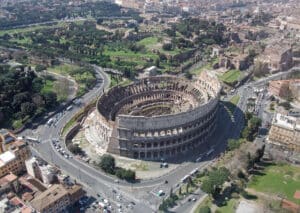The Colosseum, also known as the Flavian Amphitheatre, stands as an iconic symbol of Imperial Rome and its grandeur. This colossal structure has witnessed the rise and fall of the Roman Empire, enduring various stages of use, abandonment, and repurpose over the centuries.

Model of Ancient Rome
The Glory Days:
Constructed between AD 72 and AD 80 under the Flavian emperors, the Colosseum was primarily used for gladiatorial contests, animal hunts, mock sea battles, mythological dramas, and public spectacles. These events were often lavish and were used as a means to display the magnificence and benevolence of the Roman elite, as well as to entertain the masses.

- This design was inspired by the famous 2000-year-old ancient mosaic found in Hatay, Turkey.
- The ancient Greek word "Effrósinos," meaning "joyful" or "cheerful
- Lightweight, Classic fit, Double-needle sleeve and bottom hem

- This design inspired by an ancient Greek kalpis (a form of Greek pottery) decorated with Owl of Athena. (ca. 470 BC)
- Lightweight, Classic fit, Double-needle sleeve and bottom hem
Abandonment:
With the decline of the Roman Empire and changing public tastes, the grand spectacles began to wane in popularity. By the late medieval period, the use of the Colosseum as an entertainment venue had almost completely ceased. Several factors contributed to its decline:
- Economic Decline: As the Western Roman Empire’s economic power diminished, there were fewer resources to host grand events.
- Christianization: With the spread of Christianity, gladiatorial games came to be viewed as barbaric and were eventually banned in the early 5th century AD.
- Structural Damage: Natural disasters like earthquakes severely damaged parts of the Colosseum, making it unsuitable for large events.
Reuse and Repurpose:
After its abandonment as an entertainment venue, the Colosseum underwent various transformations, marking its resilience and adaptability:
- Fortress: During the medieval era, the Frangipani family took over the Colosseum and converted it into a fortified castle.
- Workshops and Housing: By the Middle Ages, the Colosseum’s vast space was utilized for housing, workshops, and even religious quarters.
- Quarry: Parts of the Colosseum were pilfered for its valuable stones, which were then used in the construction of other buildings throughout Rome, including St. Peter’s Basilica.
- Religious Significance: In the 18th century, the Colosseum was consecrated by the Catholic Church to commemorate the Christian martyrs believed to have died there. Stations of the Cross were installed, and it became a place of Christian pilgrimage.
Restoration and Preservation:
By the 19th and 20th centuries, the importance of preserving this iconic monument was recognized. Several restoration projects were undertaken to stabilize its structure and remove centuries of accumulated debris. Modern measures have also been adopted to combat the erosion caused by pollution and natural decay.

Colosseum Aerial View
Today, the Colosseum stands not just as a testament to the grandeur of the Roman Empire but as a symbol of endurance through the ages. Its layers of history, from a grand amphitheater to an abandoned relic, and finally to a revered monument, highlight the ebb and flow of human civilization.



Leave a Comment
You must be logged in to post a comment.